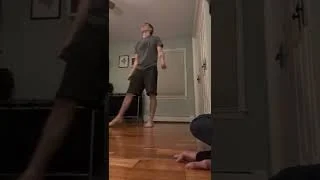Written Overview of Your Process:
1. Describe your process. How did you choose your project? Why did you choose this method?
I chose this project because I have long wanted to find ways to bring my knowledge and experience as a Powwow dancer, in combination with other dance and movement practices I am drawn to. Although this project is specifically focused on weightedness and heartbeat connections, my hope is to incorporate storytelling and Indigenous knowledge aspects and imagery as I continue to develop this for workshops and classes. This method of including FFTT approaches encouraged me to investigate some of what is at the core of movement that I know and want to share.
2. What felt good ( or provided a healthy challenge) in creating this project?
It felt good to take extended time to facilitate a sensory focused experience but there were many personal challenges around language, description, and consistency. For me with language challenges, this shows up in many ways, first being that I recognized repetition and points where I trailed off in descriptions or where I could have offered more clarity in descriptions. I also recognized points where I was inconsistent with descriptors, or could have been more inviting- I was nervous! I have been out of practice of leading or facilitating a class space for a couple of years. I do feel with more practice will come more familiarity and confidence building to branch into new language, imagery, and adding my Indigenous knowledge more overtly.
Further challenges in language include the languages or vocabulary of merging Powwow concepts with FFTT, I say this recognizing that each are rooted in different pedagogies with sometimes different emphases. Although languages or vocabulary of each can overlap, Powwow, as Choctaw ethnomusicologist Tara Browner describes, is more of a “What you see is what you get” experience, and I extend this to the dance teaching/learning experience. In Powwow practice and culture, our dances are very lead and follow, observe the teacher/facilitator, and do. Furthermore, our dances are inseparable from the drumbeat music which is a driving force and movement/dance theory predominantly held by those who practice it. The overlap I do see is that both Powwow and FFTT offer spaces for bodies to receive and move in ways that work best for those bodies, and that there is space for modification or self expression in whatever way that may be. In other words, I see open endedness and opportunities for many ways of being in both. Basing some of this project from FFTT (sometimes direct cues from Marlo’s scripts- which I found very helpful), FFTT provided some language and tools: open ended facilitation, in depth inquiry in movement exploration, and new ways to structure a class. I tried to take advantage of the opportunity to invite movers to locate their weight and heartbeat in the process, which is something I often find in teaching Powwow dance is a challenge to those new to the concepts.
3. What do you think your project offers the viewer/participat? (Tools for accessing a Flow state, more awareness of the floor, etc. )
I hope this project offers the viewer/participant awareness of connection to the ground in their movement, more awareness of self in the moment, or just a moment to feel and find ease and/or challenge.
4. If there is ONE thing that you would do differently, what is it?
Add imagery/cues based in Powwow vocabulary, symbolism, and my own Indigenous (Amskapi Pikuni) ways of knowing. This is something I tend to hold back on unless I am aware of those participating in the experience- it's something I share in live classes.
5. What did you learn from this experience that you will apply to your own training or teaching? That I can build a facilitated experience with the experience I have as a new way of approaching and sharing powwow movement/dance concepts. My hope is that when facilitating a workshop or class experience, we will start with exercises similar to what I held in this project as a way of dropping into those concepts, and then go into high energy/cardio powwow dancing with powwow music.
1-3 Sentence Summary of your project.
Sensing Foundational Concepts of Powwow Dancing
Sourced from my experience as a Native American Fancy Shawl Powwow dancer in combination with practices from this Floor Flow Teacher Training, this project meets at the intersection of mindful movement practices and foundational concepts of a basic Powwow step which includes: locating a sense of weightedness, locating one's heartbeat, and moving in “freestyle” (a term used in Powwow spaces- much like structured improvisation)

